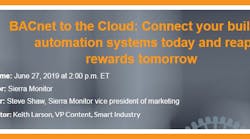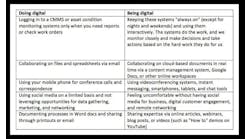Connect your building automation systems today & reap rewards tomorrow
In a few weeks, Sierra Monitor VP of Marketing Steve Shaw shares his insights during the Smart Industry webinar “BACnet to the Cloud: Connect your building automation systems today and reap rewards tomorrow.”
Today he previews his presentation and touches on homogenizing data structures, the intersection of business value and resources efficiency, and the scalability of cloud-based systems. Take a look…
Smart Industry: How do you define BACnet integration in the modern manufacturing space?
Steve: BACnet has established itself as an industry-standard lingua-franca, enabling a structure and format for disparate types of equipment to be consolidated into a single, common population. Overcoming this hurdle has enabled the rise of the IIoT and is ushering in the era of massively connected systems and equipment. Applying this to manufacturing, we’re now able to have previously isolated equipment interface with (and provide input to) other automation systems.
Smart Industry: Why is BACnet still implemented only as a local solution?
Steve: BACnet, like many established protocols, was created long before clouds or IIoT. The majority of the installed base is—and remains—local. But the mark of a well-constructed protocol is the ability to adapt, and BACnet is adapting to the new cloud-connected world. There are certainly risks associated with pushing BACnet data to the cloud, and as an industry we need to proceed with caution and pragmatism.
Smart Industry: What’s the main benefit of connecting a building automation system to the cloud?
Steve: The main benefit, of course, is the unprecedented visibility enabled by exfiltrating operational data from a facility. The ability to visualize, share and monitor from the cloud, with massive storage and compute capabilities, enables an entirely new level of optimizations to be identified, and can deliver these optimizations at a totally different price point.
Steve: I think there are three issues developing in the market today:
- Security and privacy. This is not easily solved, and will be a constant yin-yang to balance security and access.
- We’re seeing it now—homogenizing data structures between devices. If two equipment suppliers have the same data but it’s classified differently, bringing those data sets together can be complicated.
- The federation of clouds and cloud data. An app or service needs access to data from different clouds, systems, devices, and the ability to not only connect those data sources, but ensure the security/access controls as well as data integration. This is the next frontier for cloud-based control systems.
Smart Industry: What most excites you about the near future of building automation systems?
Steve: The intersection of business value and resource efficiency is very exciting. Being green isn’t altruistic; it can drive a firm return on investment. This alone is enough for many business leaders to prompt organizations to push for better control systems. In addition, the rise of cloud-based systems is going to transform the cost structure for enabling these systems. The software scalability of cloud-based systems—how previously costly enterprise systems can now be repurposed and scaled down in the cloud to provide powerful automation systems at a fraction of the cost. It’s the Amazon or Salesforce model applied to building automation, and it will be transformative.



